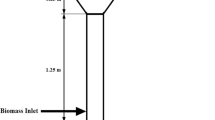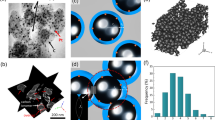Abstract
Detailed kinetic models dominate in combustion modeling. However, their application is often complicated by insufficient knowledge of a mechanism and reaction rates for heterophase interactions especially as applied to gasification. The novel approach using thermodynamic model of extreme intermediate states (MEIS) could make up an efficient alternative. MEIS is strictly deterministic and simple in structure. Along with the search for the final equilibrium, it allows partial equilibria to be found and various macroscopic phenomena to be taken into account, e.g., transport phenomena and kinetic rates. The core problem in MEIS construction is formulation of macrokinetic constrains whose form depends on the problem statement and accessible information on the process. Thermal analysis has been deployed to infer proper constraints for modeling of wooden biomass gasification. The advantage of the method consists in much higher availability of the initial information compared with detailed kinetics. Model results are in good agreement with experiment.






Similar content being viewed by others
References
De Souza-Santos ML. Solid fuels combustion and gasification: modeling, simulation and equipment operation. New York: CRC Press; 2004. p. 400.
Hobbs ML, Radulovich PT, Smoot LD. Combustion and gasification of coals in fixed beds. Prog Energy Combust Sci. 1993;19:505–86.
Keiko AV, Svishchev DA, Kozlov AN, Donskoy IG. Research on solid fuel bed thermochemical conversion processes. In: Zaytcev AV, editor. Gasifier technology in power engineering. Yekaterinburg: Sokrat; 2010. p. 611 (in Russian).
Baratieri M, Baggio P, Fiori L, Grigiante M. Biomass as energy source: thermodynamic constraints on the performance of the conversion process. Bioresour Techonol. 2008;99:7063–73.
Gorban A, Kaganovich B, Filippov S, Keiko A, et al. Thermodynamic equilibria and extrema. Analysis of attainability regions and partial equilibria. New-York: Springer; 2006. p. 305.
Kaganovich BM, Keiko AV, Shamansky VA. Equilibrium thermodynamic modeling of dissipative macroscopic systems. Thermodynamics and kinetics systems. Adv Chem Eng. 2010;39:1–74.
Kaganovich BM, Filippov SP, Keiko AV, Shamansky VA. Thermodynamic models of extreme intermediate states and their applications in power engineering. Therm Eng. 2011;58(2):143–52.
Frenklach M. Modeling. In: Gardiner WC, editor. Combustion chemistry. New York: Springer; 1984. p. 509.
Reich L, Stivala SS. Computer analysis of non-isotermal TG data for mechanism and activation energy. Part. 1. Thermochim Acta. 1984;73(1–2):165–72.
Keiko AV, Svishchev DA, Kozlov AN, Donskoy IG. Study of physical constraints on controllability of low-grade solid fuel conversion processes. Therm Eng. 2012;1:1–7.
Author information
Authors and Affiliations
Corresponding author
Rights and permissions
About this article
Cite this article
Kozlov, A., Svishchev, D., Donskoy, I. et al. Thermal analysis in numerical thermodynamic modeling of solid fuel conversion. J Therm Anal Calorim 109, 1311–1317 (2012). https://doi.org/10.1007/s10973-012-2626-6
Published:
Issue Date:
DOI: https://doi.org/10.1007/s10973-012-2626-6




